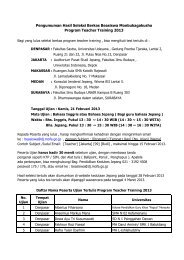9700_y16_sy
9700_y16_sy
9700_y16_sy
You also want an ePaper? Increase the reach of your titles
YUMPU automatically turns print PDFs into web optimized ePapers that Google loves.
Cambridge International AS and A Level Biology <strong>9700</strong> <strong>sy</strong>llabus Practical assessment<br />
• Identify which key variables must be standardised in order to test a hypothesis effectively. Only<br />
variables that are appropriate for the given scenario and likely to have some effect on the investigation<br />
are expected, for example, time of investigation, but not those likely to have a very small effect, for<br />
example, using the same test-tube.<br />
Methods<br />
From a given scenario, candidates will be assessed on their ability to describe a method that could be used<br />
by another person without any further information to collect the necessary data without difficulty.<br />
When describing the method, candidates should be able to:<br />
• Use the information provided in the scenario to describe how to vary the independent variable, and the<br />
ways in which they would make sure they had measured its values accurately<br />
• Describe how to measure the dependent variable. This could include using either, as appropriate, the<br />
apparatus or materials specified in the scenario or measuring instruments chosen to measure the<br />
correct quantity to a suitable number of significant figures. This may include the use of monitoring<br />
devices and computer technology to record changes<br />
• Describe how to standardise each of the other key variables using appropriate methods for the<br />
apparatus and nature of the investigation, e.g. using a dropping pipette is not appropriate to measure<br />
small volumes of a solution<br />
• Describe, where appropriate, suitable volumes and concentrations of reagents, and explain how<br />
different concentrations would be prepared<br />
Concentrations may be specified:<br />
– in %(w/v), by adding a known mass of solute to a small volume of solvent, mixing until fully<br />
dissolved and then making up to the final volume with solvent<br />
– in mol dm –3 , by dissolving the molar mass of solute and then making up to 1 dm 3 with solvent<br />
Dilutions may be made by:<br />
– serial dilution, by making the same dilution step again and again, using the previous dilution as the<br />
input to the next dilution in each step. Since the dilution-factor is the same in each step, the dilutions<br />
are a geometric series<br />
– proportional dilution, by adding a unit volume of a solution of a known concentration to a solvent to<br />
obtain the required concentration, e.g. to dilute a stock solution by 5, 1 cm 3 of the stock solution is<br />
added to 4 cm 3 of solvent. This gives a 1:5 dilution<br />
• Describe, if appropriate, any control experiments to make sure that it is the independent variable that is<br />
affecting the dependent variable and not some other factor<br />
Control experiments can be of two types:<br />
– where all factors are kept identical to the experimental set up except that the value of the<br />
independent variable is zero, for example when water is used instead of a test solution<br />
– where the control is to confirm that, for example, it is an organism that is causing a particular effect,<br />
by leaving out or replacing the organism with non-living material, e.g. sterile glass beads instead of<br />
an insect in a respirometer<br />
• Describe, in a logical sequence, the steps involved in the procedure including how to use the apparatus<br />
to collect results<br />
• Describe how to ensure the quality of results by considering any anomalous results and the spread of<br />
results by inspection and then by using standard deviation, standard error or 95% confidence interval<br />
(CI). Results are precise if they are repeatable by the same candidate and reproducible by others<br />
• Describe how to ensure the validity of the results by considering both the success at measuring the<br />
intended dependent variable and the precision required<br />
66 www.cie.org.uk/alevel Back to contents page





